How to prevent pressure wounds
|
Pressure wounds can have terrible even deadly consequences. If you have a high spinal cord injury, it's very easy to get them, and very very hard to heal. You don't want them!
Things to do when sitting in a wheelchair all day:
- Get the best possible cushion, and care for it. It's not a matter of how soft it is; what counts is the shape, how well the pressure is spread, reduced at the sitbones. Also important is the fabric around the cushion; there should be no tension on it! And for some cushions it's very important that it has support not just at the bottom, but also on all sides, to prevent tension on the surface of the cushion.
- Make sure all wrinkles are removed from your clothes, especially at the sitbones.
- Make sure there is no tension in the pants's fabric, especially at the sitbones. Tension can be worse than wrinkles!
- Tilt the chair backwards some 15 to 20 degrees. That will bring some of your weight to your back, away from your sitbones. Also will it make you sit more stable, reducing the tendency to slide forwards. A sliding kind of tension can be really bad for your skin.
- If the skin at your sitbones is red, with a sharp edge in color; stay in bed! Don't risk it, not even if you had a vacation planned.
- Driving outside can be bumpy, but I learned this is a good thing. Not too bumpy of course, but a bit of motion all the time is good for the flesh.
- EMS, Electrical Muscle Stimulation, doing that at least 4 times a week helps, it makes your muscles work, and that's definitely a good thing! Be sure to get the wide electrodes (5x10cm). There are machines that aren't expensive anymore, and pretty good quality, like this one: Sanitas SEM 40 Digital EMS/TENS. Aim for the "Gluteus Maximus"
|
PRESSURE RELIEVING THEORY
Pressure wounds (search for it if you dare) are really nasty and can kill you. So take good care you don't get them. Pressure wounds are wounds caused by pressure (surprise!). If you sit in a wheelchair, the pressure you have to deal with is equal to your weight. That's why I'd like to be a small person and live on the moon.
The most pressure is on the flesh between your sit bones and the cushion. Taking some pressure away there is possible, but it can't disapear, so other areas have to take over that pressure. Goal of a cushion that prevents pressure wounds, is to spread the pressure equally over a large surface. "Pressure relieving".
A fetus (foetus) inside the placenta is perfectly pressure suported, but putting me in that position would be very much Matrix like (The cocoons in that movie).
The ideal pressure relieving situation would be floating on mercury liquid metal. But that is no option, because it's too heavy, and poisonous! Also is it cold and very expensive.
The ideal material isn't especially soft, the most important for it is to have the right shape. It may be as hard as stone, al long as the cushion has the right shape. But a body is dynamic, so stone is not a good option after all. The ideal cushion has to be able to adapt to a changing shape.
Air is: light, non-toxic, isolating, and very cheap. But air weighs very little, so it doesn't lift you up like mercury does. Putting air inside an airtight bag stops the air from flowing away. A couple of problems though:
- If it gets leak, your protection is fully gone.
- The bag's material may not be flexible, because the air would then just bubble out like chewing gum. When you put your weight on an airbag, the surface tension will become very high, almost as hard as stone and NOT being flexible.
- Sitting on one airbag is very unstable, like sitting on a ball.
- An airtight bag doesn't breathe, can be sweaty.
All together air seems no option, but there are some good solutions:
- Putting the airbag in an open box, will stop the bag's skin from popping out sideways.
- Sitting on two or four airbags instead of one, will make it very stable.
- Filling these two or four bag's with tens of smaller air bags/elements, will protect you, even when a couple of elements get leak.
- Placing the bones you sit on inbetween airbags will reduce the surface tension effect to a minimum. (this only works with the model 4)
- The splits in the cushion, allows a small bit of air to circulale. Make many small holes in the box too, to improve ventilation.
|

This would be the ideal air element: a very flexibel but not stretching ball, filled with air, with no extra air pressure. Very smooth on the outside, and not easy to turn leak. Soap bubbbles act the way these air elements should. I don't know of a product like this, and imagine it can be pretty hard to make. The size should be some 4 cm diagonal. Silicon breasts filled with air maybe? (probably too big and expensive, and not air-filled). If any of you know of a product like this on the market, please let me know.
|
 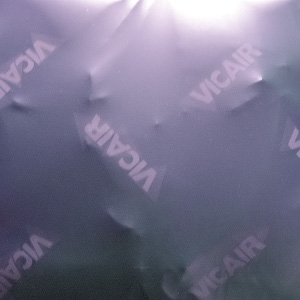
This illustration above is the solution that VICAIR invented, and patented. They call their air elements "SmartCells". Made out of a tube, with two seals. The SmartCells have a very smooth/slippery surface, and they do not leak air easily, so that makes them very secure to use (except for the light blue SmartCells from 2010, the newer ones are much better). Compared to the ideal airball element, the SmartCells are much less expensive to make, but have 4 sharp corners that can sometimes sting through the cushion. Not a good idea to press corners in a sensitive skin!
I do sleep on a VICAIR matras, because it's so secure and silent, but I regularly have pain from the points/bumps. What helps is placing 3D fabrics on top, and I have good experience with placing a 7 cm Tempur "NASA foam" on top.
|
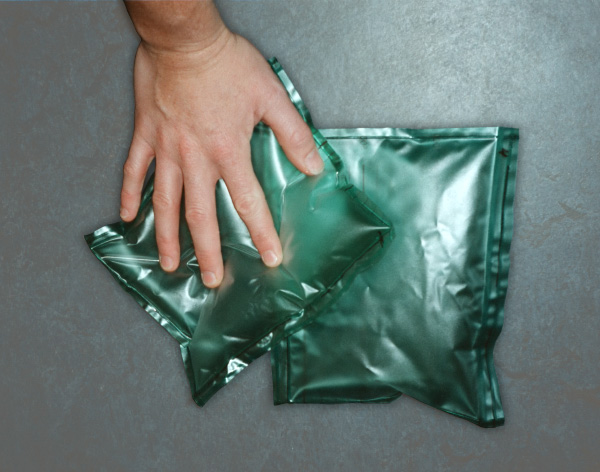
This is the solution I found for my LaesieCushion: very flexibel though non stretching bags. These bags don't need a very smooth surface, because there's no need for the air elements to move. As they are only filled to about 20%, the air inside can move around freely. I sealed these bags myself, as I couldn't find ready ones for sale.
I have a lot more comfort sitting on them instead of the VICAIR elements, but my air elements do leak a bit air, so I have to quick-check the cushion every day.
|
|
There are lots of wheelchair cushions on the market that are designed to prevent pressure wounds, but I had troubles with all the cushions I tried. They hurt me and caused redness, the early stages of pressure wounds. I frequently had to stay in bed to let it heal.
So I then decided to design my own cushion, and I did with success. I've been sitting on my LaesieCushion for about nine years now, without major troubles. The cushion feels as if it were filled with gel, but it's actually air, which is of lower weight than gel and not cold.
Now I would like to share this solution with you. If you can't find a good cushion out there, or can't afford one, you can build my design yourself and see if it fits you too.
Don't ask me if I can make one for you: I can't. I couldn't find a company than was willing and able to fight the competition, so my design is now free for personal use. If you are a company and interested: contact me. Know that "the others" have very similar products (though not as good as mine!) and many patents.
Here's some theory, and information with which you can make this cushion yourself:
|
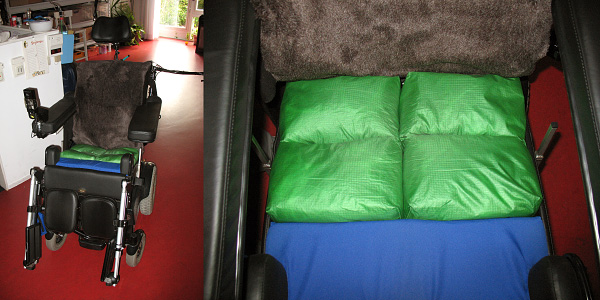
HOW TO MAKE YOUR OWN LAESIECUSHION
(for your personal use only, not to sell)
I would only suggest the "model 4" because it's more stable, has better ventilation, and gives even less pressure on the sit bones, IF positioned right.
|
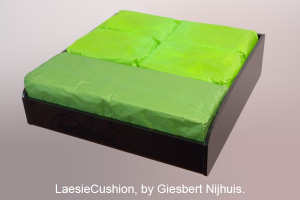 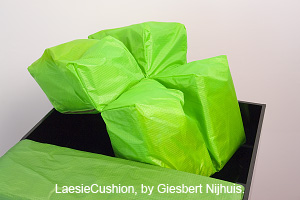
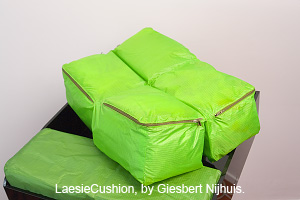 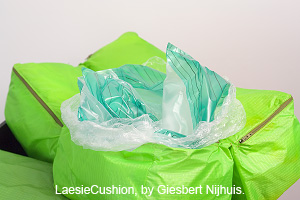
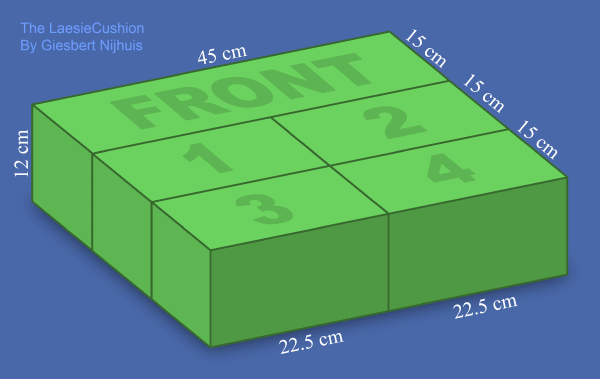
FOR WHO
Since every person is unique, my design will not be ideal for everyone. I'm 190 centimeters tall, and paralyzed up to my shoulders. If you can move much more of your body, then you'll probably be better of with an other -thinner- cushion.
SIZE
This cushion is made for my size (see picture). Children would need a smaller one, and wide people a bigger one. Too small isn't good, obviously, but too wide isn't good either! (the bags want to pop out sideways). Mine is about 8 cm wider than my hips are.
BOX
There must be a box! This type of cushion has an absolute need for a box that supports the cushion's bottom and sides. I see people sit on VICAIR cushions without a box. Then you could as well sit on a cheap piece of foam, because the surface tension becomes really high without the support of a box.
- Make many small holes in the box-bottom, to improve ventilation.
- The front should be lower, because you really don't want your legs to touch it.
- The back of the box should be lower also, especially in the middel. Beware for chairs with variable back support. Your back may not touch the box.
THE OUTHER BAGS
This part is really hard to make. I found coated nylon ripstop fabric used for kites and parafoil, to be the best choice, because this material is very thin and strong, and dries really fast too (image). No need to make it green like mine, there are many colors to choose from. Use a strong synthetic kind of thread. The four zippers need to be long, so a change or check of the inside is easy. (about 37 cm each, in my cushion)
THE SEALED BAGS
I use a particularly kind of.. urine bags (new ones!), because they are airtight, strong, flexible, and can be sealed. They are expensive. You'll also need a sealer and maybe a simple air pump. I searched for an alternative, but other bags I found were either too hard or too weak. Please let me know if you find a good alternative.
CLEAN
The LaesieCushion's outside can be hand washed easily, and dries really quick. You don't want to wash all the air elements, so that's what the plastic bag is for. I use two slightly oversized plastic bags to protect the air elements. In case of a little accident, the inner bag stays clean, and the outher bag can be thrown away.
FRONT
The front part is at the bottom filled with 4 cm foam, to support the position of the main cushion. The remaining space (8 cm high) is filled with the airbags.
HELP
The LaesieCushion isn't easy to make, so you'll probably be better of working together with someone really handy.
Last note: Boys have an extra problem, or two actually..
Therefore I place a small piece of foam inbetween the front two airbags (between 1 and 2), to create a bit more space there.
OK, good luck with it. I would really appreciate your feedback if you build one.
|
|





















